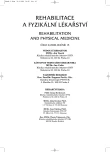Massage as a Remedy to Compensate Changes Related to Organism Aging
Authors:
J. Jančová; P. Nováková; M. Plívová
Authors‘ workplace:
Katedra tělovýchovného lékařství a zdravotní tělesné výchovy FTVS UK, Praha
vedoucí katedry doc. PhDr. B. Hošková, CSc.
Published in:
Rehabil. fyz. Lék., 15, 2008, No. 2, pp. 82-88.
Category:
Original Papers
Overview
General characteristics of aging are often commented as individual differences in aging process, asynchronous aging of functional systems in each and every person, and least but not last the involution and decrease of structures and functions. As general consequences of aging are considered organs reserves loses, decrease of compensatory mechanisms, progressive decrease of physical and psychological reactivity including overwhelmingly decreased adaptability to changes of inner and outer environment. Many authors state that self-efficiency of the elderly is the major condition for active aging and its quality. In present paper the authors deal with massage and its possible outcomes that may influence the aging process.
Key words:
aging, sarcopenia, massage, contraindication of massage
Sources
1. TOPINKOVÁ, E.: Geriatrie pro praxi. Praha, Galén, 2005.
2. TISCHER, H.: Blahodárná masáž. Praha, Grada Publishing, 2006.
3. PICHAUD, C.: Soužití se staršími lidmi. Praha, Portál, 1998.
4. KVAPILÍK, J.: Sportovní masáž pro každého. Praha, Olympia, 1991.
5. SEDMÍK J.: Masáže. Kompletní kniha masážních technik. III. vydání. Praha, Svoboda, 1999
6. HOŠKOVÁ, B.: Masáž ve sportu. Praha, Olympia, 2000.
7. KALVACH A SPOL.: Geriatrie a gerontologie. Praha, Grada Publishing, 2004.
8. SKELTON, D. A.: Effects of physical activity on postural stability. Age and ageing, 2001, s. 33-39.
9. ERIKSSEN, G.: Physical fitness and changes in mortality. Sports Med. 31, 2001, s. 571-576.
10. GIBBONS, S., COMMERFORD, M.: Strength versus stability: Part I. Concept and Terms. Orthopaedic Division review, March/April, 2001, s. 21-27.
11. SUCHOMEL, T., LISICKÝ, D.: Progresivní dynamická stabilizace bederní páteře. Rehabilitace a fyzikální lékařství, 3, 2004, s. 128-136.
12. KIRKENDALL, D. T., GARETT, W. E.: The effects of aging and training on skeletal muscle. Am. J. Sports. Med., 26, 1998, s. 598-602
13. BROOKS, S. V., FAULKNER, J. A.: Skeletal muscles weakness in old age: underlying mechanisms. Med. Sci. Sports Exercise, 26, 994, 4, s. 432-439.
14. BROOKS, G. A., FAHEY, T. D.: Exercise physiology, human bioenergetics and its application. NY, Mac-Millan, 1985.
15. MARTIN, C., FARRAR, R. P., WAGNER, B.M., SPIRDUSO, W. W.: Maximal power across the life span. J. Gerontol. A Biol. Sci. Med. Sci., 55, 2000, 6, M311-M316.
16. SMITH R,G., SUN, Y., BETANCOURT, L., ASNICAR, M.:. Growth hormone secretagogues: prospects and potential pit-falls. Clin. Endocrin. Metanol., 18, 2004, 3,: s. 297-304.
17. DELBONO, O., O’ROURKE, K. S., ETTINGER, W. H.: Excitation calcium release uncoupling in aged single human skeletal muscle fibres. J. Membrane Biology, 148, 1995, s. 211-222.
18. SATO, T., AKATSUKA, H., KITO, K. et al.: Age changes of myofibrils of human minor pectoral muscle. Mech. Ageing and Develop, 34, 1986, 3, s. 297-304.
19. PLYLEY, M. J.: Fine-tuning muscla capilary supply for maximum exercise performance. Kardiology, 1990, 6, s. 25-34.
20. KNORTZ, K:. Muscle physiology applied to geriatric rehabilitation. Topics geriatr Rehabil., 1987, 2, s. 1-12.
21. WISWELL, R. A., JAQUE, S. V., HAMILTON-WESSLER, M.: Exercise and muscle strength. In: Merley J. E., Glick, Z., Rubenstein, L. Z., eds. Geriatric nutrition. NY, Raven Press, 1990, s. 447-456.
22. TŮMOVÁ, J.: Ověření vlivu pohybového programu na zlepšení stability u starších osob pomocí posturografie. Dizertační práce, Praha, FTVS UK, 2003.
23. KOHLÍKOVÁ E.: Patofyziologie ve schématech. Univerzita Karlova Praha, Karolinum, 2004.
24. VRABEC, P., LISCHKEOVA, B., SVĚTLÍK, M., SKŘIVAN, J.: Rovnovážný systém: I. Obecná část. Praha, Triton, 2002.
25. JANČOVÁ, J., KOHLÍKOVÁ, E.: Regresní změny stárnoucího organismu a jejich vliv na posturální stabilitu. Rehabilitace a fyzikální lékařství, 2007, s. 155-162.
26.. EDSTRÖM, E., ULFHAKE, B.: Sarcopenia is not due to lack of regenerative drive in senescent skeletal muscle. Aging Cell, 2005, 4, s. 65–77.
27. SMITH, L. L., KEATING, M. N., HOLBERT, D., SPRATT, D. J., MCCAMMON, M. R., SMITH, S. S., ISRAEL, R. G.: The effects of athletic massage on delayed onset muscle soreness, creatine kinase, and neutrophil count. A preliminary Report. JOSPT, 1994. roč. 19, č. 2, s. 93-98.
28. TIIDUS, P. M.: Manual massage and recovery of muscle function following exercise. A Literature Rewiew. JOSPT, 1997, roč. 25, č. 2, s. 107-111.
29. BOONE, T., COOPER, R., THOMSON, W. R.: A physiologic evaluation of the sports massage. Athletic Training, JNATA, 26, 1991, s. 51-54.
30. WEERAPONG, P., HUME, P. A., GREGORY S. K.: Effects on performance, muscle recovery and injury prevention. Sports Med., 35, 2005; 3, s. 235-256.
31. WEINBERG, R., JACKSON, A., KOLODNY, K.: The relationship of massage and exercise to mood enhancement. Sport Psychol, 1988; 2, s. 202-211.
32. HEMMINGS, B.: Sports massage and psychological regeneration. Br. J. Ther Rehabil., 7, 2000, 4, s. 184-188.
33. LANGMEIER, J., KREJČÍŘOVÁ, D.: Vývojová psychologie. Praha, Portál, 1999.
34. VÉLE, F.:, Kineziologie pro klinickou praxi. Praha, Grada, 1997. ISBN 80-7169-256-5.
35. http://www.diazivot.cz/.
Labels
Physiotherapist, university degree Rehabilitation Sports medicineArticle was published in
Rehabilitation & Physical Medicine

2008 Issue 2
Most read in this issue
- Natural Treatment Sources in the Czech Republic
- New Aspects in the Roswitha Brunkow Method by Following the Activity of Selected Muscles by EMG
- Myths about the Stabilization System
- The Comparison of Functional Foot Types Occurrence in Men and Women
